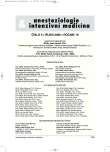Difficulties in implementation of the recommendations for the diagnosis and treatment of severe sepsis and septic shock
Authors:
Firment Jozef; Hudák Vladimír; Grendel Tomáš
Authors‘ workplace:
Oddelenie anesteziológie a intenzívnej medicíny, FN LP a LF UPJŠ Košice, Slovenská republika
Published in:
Anest. intenziv. Med., 19, 2008, č. 5, s. 252-259
Category:
Intensive Care Medicine - Original Paper
Overview
Objective:
Severe sepsis and septic shock are most important factors of high morbidity and mortality in critically ill patients. The aim of our study was to assess the implementation of the recommendations for the diagnosis and treatment of severe sepsis and septic shock in our department according to the Surviving Sepsis Campaign.
Setting:
University Department of Anaesthesiology & Intensive Care Medicine.
Materials and methods:
The 2004 patients were enrolled retrospectively, 2004 being the year of implementation of the recommendations. Since 2005 we have been enrolling patients prospectively with the recommendations fully in force.
Results:
Between 2004 and 2006, 1293 patients were admitted to the ICU; 103 (8%) of them were diagnosed with severe sepsis or septic shock. The mortality by year was as follows: 72% in 2004, 63% in 2005 and 61% in 2006. All the steps of the resuscitation bundles were completed in 7% patients in 2004, in 16% patients in 2005 and in 11% patients in 2006. The 24-hour management bundle steps were completed in no patient in 2004 and 2005, and in 56% patients in 2006. When assessing the 100% implementation of the bundles, one of the aims of the Surviving Sepsis Campaign, we found that in 2004 and 2005 we did not meet the criteria of complete implementation in any patient and in 2006 we met the criteria in 8% patients.
Conclusion:
The implementation of the Surviving Sepsis Campaign bundles to everyday practice is a long-term process. The high mortality in septic patients is explained by the development of septic shock at the time of initiating the standardized therapy.
Key words:
severe sepsis – septic shock – critically ill patient
Sources
1. Firment, J. Výzva Č-S fóra pre sepsu adresovaná ČLS JEP a SLS. Medicínsky monitor, 2005, roč. 1, s. 29.
2. Firment, J., Záhorec, R. Odporúčania pre liečbu ťažkej sepsy dospelých. Medicínsky monitor, 2004, roč. 3, s. 30–35.
3. Dellinger, R. P., Levy, M. M., Carlet, J. M. et al. Surviving Sepsis Campaign: International guidelines for management of severe sepsis and septic shock. Inten. Care Med., 2008, 34, p. 17–60.
4. Záhorec, R., Firment, J., Straková, J., Mikula, J., Malík, P. et al. Epidemiology of Severe Sepsis in Intensive Care Units in Slovak republic. Infection, 2005, 33, p. 93.
5. Brun-Buisson, C., Meshaka, P., Pinton, P. et al. EPISEPSIS: a reappraisal of the epidemiology and outcome of severe sepsis in French intensive care units. Inten, Care Med,, 2004, 30, p. 580–588.
6. French, C. J. The epidemiology of sepsis – is Australasia different? Crit. Care Res., 2006, 8, p. 219–222.
7. Ferrer, R., Edusepsis investigators: Sepsis mortality can be reduced by an educational program based on guidelines. Inten. Care Med., Supplement, 2007, S5.
8. Grendel, T., Hudák, V., Firment, J. Nízke dávky kortikoidov a septický šok. Rozhl. Chir., 2008, 87, 3, p. 158–164.
9. Cheatham, M. L. Resuscitation end points in severe sepsis: Central venous pressure, mean arterial pressure, mixed venous oxygen saturation, and intra-abdominal pressure. Crit. Care Med., 2008, 36, p. 1012–1013.
10. Dombrovskiy, V. Y., Martin, A. A., Sunderram, J., Paz, H. Rapid increase in hospitalization and mortality rates for severe sepsis in the United States: A trend analysis from 1993 to 2003. Crit. Care Med., 2007, 35, p. 1244–1250.
11. Vincent, J. L., Sakr, Y., Sprung, C. L., Ranieri, V. M., Reinhart, K. et al. Results of the SOAP study. Crit. Care Med., 2006, 34, p. 344–353.
12. Moreno, R. P., Metnitz, B., Adler, L., Hoechtl, A., Bauer, P., Metnitz, P. G. H., SAPS 3 Investigators: Sepsis mortality prediction based on predisposition, infection and response. Inten. Care Med., 2008, 34, p. 496–504.
13. Haas, L. E. M., Tjan, D. H. T., van Zanten, A. R. H. An introduction to sepsis. Lifelines in Critical Care and Anaesthesia, 2006, 10, p. 2–5.
14. Vincent, J. L. PLoS Medicine. Dostupné na:
www.plosmedicine.org, 2006, Vol. 3, 9, e346, p. 1488–1491.
15. Annane, D., Vignon, P., Renault, A., Bollaert, P. E., Charpentier, C., Martin, C., Troché, G., Ricard, J-D., Nitenberg, G., Papazian, L., Azoulay, E., Bellissant, E., CATS Study Group: Norepinephrine plus dobutamine versus epinephrine alone for management of septic shock: a randomised trial. Lancet, 2007, 370, p. 676–84.
16. Albanese, J., Leone, M., Garnier, F., Bourgoin, A., Antonini, F., Martin, C. Renal effects of norepinephrine in septic and nonseptic patients. Chest, 2004, 126, p. 534–539.
17. Van den Berghe, G., Wilmer, A., Hermans, G., Meersseman, W., Wouters, P.J. et al. Intensive Insulin Therapy in the Medical ICU. NEJM, 2006, 354, p. 449–461.
18. Brunkhorst, F. M., Reinhart, K. Intensive insulin therapy in the ICU: benefit versus harm? Inten. Care Med., 2007, 33, p. 1302.
19. Goldhill, D. R. et al. The longer patients are in hospital before Intensive Care admission the higher their mortality. Inten. Care Med., 2004, 30, p. 1908–1913.
20. Ramsay, G. Update on Surviving sepsis campaign. CD1, 8. PG Kurz Sepse a MODS. Ostrava 2006.
Labels
Anaesthesiology, Resuscitation and Inten Intensive Care MedicineArticle was published in
Anaesthesiology and Intensive Care Medicine

2008 Issue 5
Most read in this issue
- General anaesthesia with an awake period for brain surgery
- Difficulties in implementation of the recommendations for the diagnosis and treatment of severe sepsis and septic shock
- Immunopathogenenis of sepsis
- Twenty five years of selective digestion decontamination – the questions remain unanswered
